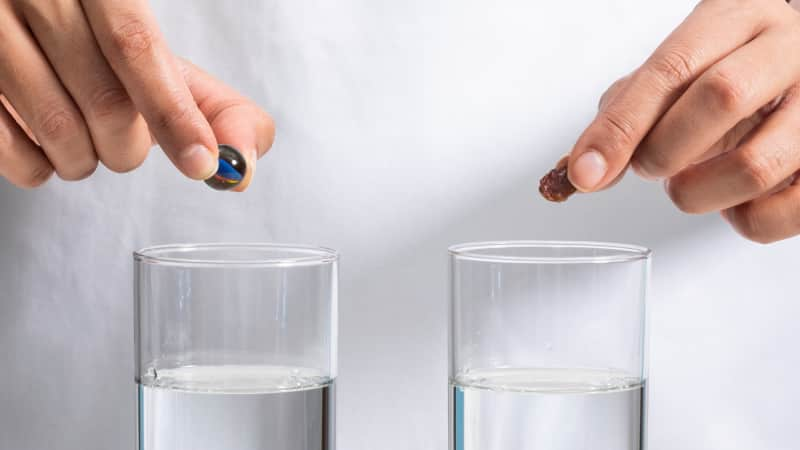Have you ever noticed that before you open it, you can’t see any bubbles in a bottle of soda or seltzer?
What Makes Fizzy Drinks Fizzy?
Published Jan. 27, 2023.

They only appear once you open the bottle and take a drink or pour the liquid into a glass.
In this experiment, kids can explore where those bubbles come from by dropping two different objects—a smooth marble and a rough raisin—into glasses of seltzer and observing what happens.
Sign up for the Cook's Country Dinner Tonight newsletter
10 ingredients. 45 minutes. Quick, easy, and fresh weeknight recipes.
Materials
- 2 tall, clear drinking glasses, both the same size and shape
- 3 cups (24 ounces) cold seltzer water
- 1 clean marble or ball bearing
- 2 raisins or dried cranberries
- Spoon
Let’s Go!
1. Make a prediction: Which glass of seltzer do you think will have more bubbles, the one with the marble or the one with the raisin? Why do you think so?
2. Fill both drinking glasses with cold seltzer until they are about ¾ full (be sure to fill both glasses to the same level).
3. Place glasses side by side on counter. Hold marble about 1 inch above surface of seltzer in 1 glass. Hold raisin about 1 inch above surface of seltzer in second glass (make sure marble and raisin are at same height).

4. Observe your results: Let go of marble and raisin at same time, letting them drop into their respective glasses. Observe what happens for 30 seconds.
5. Use spoon to retrieve marble and raisin from glasses. Repeat steps 3 and 4 with marble and second raisin. This time, observe what happens for at least 5 minutes. How do your results compare with your prediction from step 1?
Understanding Your Results
The Big Ideas
- The bubbles in seltzer and soda are made of carbon dioxide gas. In a sealed bottle, the gas is dissolved in the liquid—you can’t see it.
- To become a bubble, dissolved carbon dioxide gas needs a nucleation site, which can be anything from a speck of dust in a glass to your marble or raisin.
- The wrinkly raisin has more nucleation sites than the smooth marble, so it creates more bubbles right away. The marble creates fewer bubbles, but it makes the liquid bubbly for a longer time.
When we embarked on this effervescent experiment in the ATK Kids Recipe Lab, we observed lots of bubbles right away in the glass with the raisin. There were fewer bubbles in the glass with the marble, but we observed bubbles for a longer time.

The bubbles in seltzer or soda are made of carbon dioxide gas. When seltzer is in a sealed bottle, the gas is dissolved in the liquid—you can’t see it. When you open the bottle, some of the dissolved carbon dioxide turns back into a gas and escapes as bubbles. But to get the bubbles really popping, you need some help.
Just like Clark Kent needs a phone booth to change into Superman, dissolved carbon dioxide needs a special place to become a bubble, called a nucleation (“new-clee-AY-shun”) site. Bubbles form at nucleation sites and rise through the beverage until they pop at the surface. A nucleation site can be anything from a tiny fiber from a towel to a speck of dust to the surfaces of the marble and raisin.
The Complete Cookbook for Young Scientists
America’s Test Kitchen Kids brings delicious science to your kitchen! Over 70 kid-tested, kid-approved recipes and experiments teach young chefs about the fun and fascinating science of food.The wrinkly raisin has more nucleation sites than the smooth marble. And more nucleation sites means more bubbles. But there’s only so much carbon dioxide dissolved in the seltzer water. Eventually, the bubbles slow down because there’s not much carbon dioxide left. The gas is used up more quickly when there are more nucleation sites, as in the glass with the raisin. In the glass with the smooth marble, there were fewer bubbles at any given moment, but the seltzer stayed bubbly for longer.

